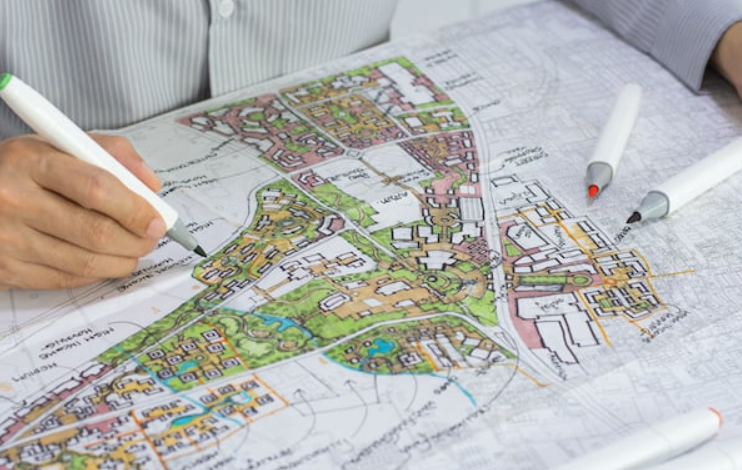Essential Elements of Effective Site Plan Drawings for Urban Development

Urban development is a complex and multifaceted process that requires careful planning and execution. One of the critical components of successful urban development is the site plan drawing. These drawings serve as a blueprint for the construction and organization of a space, outlining essential features such as buildings, roads, landscaping, and utilities. For a site plan to be effective, it must incorporate several essential elements that ensure functionality, sustainability, and aesthetic appeal
Understanding Zoning Regulations
Before any site plan drawing can be effectively conceptualized, it is crucial to understand local zoning regulations. Zoning laws dictate how land can be used, including restrictions on building types, the density of development, and the height of structures. A comprehensive site plan must align with these regulations to avoid legal issues and ensure that the development meets community standards. Understanding the nuances of zoning allows developers to optimize the layout for efficiency while adhering to legal requirements.
See also: Put Your Home to Work: How a Home Equity Loan in Hudson, WI Can Help You Achieve Life’s Big Goals
Topography and Site Analysis
An effective site plan drawing must include a thorough analysis of the site’s topography. Topographical features such as slopes, elevation changes, and natural drainage patterns can significantly influence the layout of buildings and infrastructure. By incorporating these elements into the design, developers can create spaces that minimize environmental impact, enhance accessibility, and improve overall functionality. Conducting a site analysis also helps identify any potential challenges, such as soil stability or flooding risks, which must be addressed in the planning phase.
Integration of Transportation Networks
Transportation networks are essential elements that should be included in any site plan drawing. Effective urban development relies on seamless connectivity between different areas, making it vital to integrate roads, pedestrian pathways, and public transit options into the site design. Efficient circulation patterns not only facilitate movement but also enhance safety by minimizing conflicts between vehicles, cyclists, and pedestrians. By designing a comprehensive transportation network, developers can promote walkability, reduce traffic congestion, and improve overall accessibility.
See also: How Management Keeps Companies Running Smoothly
Landscaping and Green Spaces
Incorporating landscaping and green spaces into a site plan is vital for enhancing the aesthetic appeal of urban developments. Green spaces provide multiple benefits, including recreational opportunities, habitat for wildlife, and improved air quality. Effective site plan drawings should include parks, gardens, and tree-lined streets to create a vibrant and inviting environment. Additionally, the design of these spaces should consider the needs of the community, providing areas for social interaction and relaxation. By prioritizing landscaping, developers can contribute to the overall quality of life for residents and promote sustainability.
Building Placement and Orientation
The placement and orientation of buildings within a site plan drawing are critical for maximizing natural light, ventilation, and views. Careful consideration of a building’s position can influence energy efficiency and occupant comfort. For example, buildings should be oriented to take advantage of passive solar heating while minimizing heat loss during colder months. Furthermore, the layout of buildings can facilitate social interaction and community engagement by creating inviting public spaces. Thoughtful planning in this aspect not only enhances the functionality of the development but also fosters a sense of community.
Utility Infrastructure
A well-designed site plan must account for necessary utility infrastructure, including water supply, sewage systems, electricity, and telecommunications. Effective planning ensures that these utilities are easily accessible and can support the anticipated development density. It is essential to include detailed layouts for utility lines, access points, and service areas in the site plan drawing. Early consideration of utility infrastructure can prevent costly modifications later in the construction process and ensure that the development is equipped to meet future demands.
Environmental Considerations
Sustainable urban development requires an awareness of environmental impacts. An effective site plan drawing should incorporate strategies for minimizing ecological footprints, such as stormwater management techniques, green roofs, and energy-efficient building designs. These elements not only contribute to environmental sustainability but can also enhance the marketability of the development. Incorporating renewable energy sources, such as solar panels, can further position a project as environmentally responsible while lowering operational costs for future residents or tenants.
Community Engagement
Successful urban developments often arise from community engagement and collaboration. An effective site plan drawing should reflect input from various stakeholders, including residents, local businesses, and government officials. Engaging the community in the planning process helps identify specific needs and concerns, leading to more inclusive and well-rounded development. By incorporating feedback and fostering transparency, developers can build trust and create spaces that resonate with community values.
Flexibility and Adaptability
Urban environments are constantly evolving, and effective site plan drawings should account for future changes and growth. Flexibility in design allows for adaptations to new technologies, shifts in demographic trends, or changes in community needs. For example, incorporating mixed-use spaces can provide opportunities for commercial, residential, and recreational uses, accommodating a diverse range of activities. By designing with adaptability in mind, developers can create resilient urban spaces that remain relevant over time.
Conclusion
Effective site plan drawings are crucial to the success of urban development projects. By integrating zoning regulations, analyzing topography, and considering transportation networks, landscaping, building placement, utility infrastructure, environmental factors, community engagement, and flexibility, developers can create functional, sustainable, and aesthetically pleasing urban spaces. Through careful planning and attention to detail, site plan drawings can serve as powerful tools for transforming urban landscapes and enhancing the quality of life for communities.





